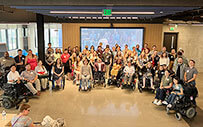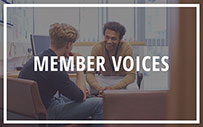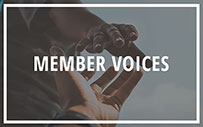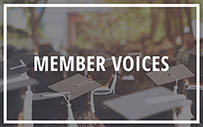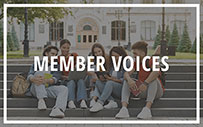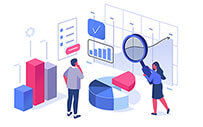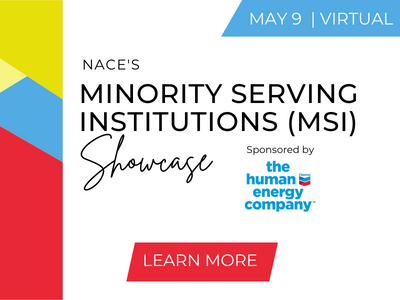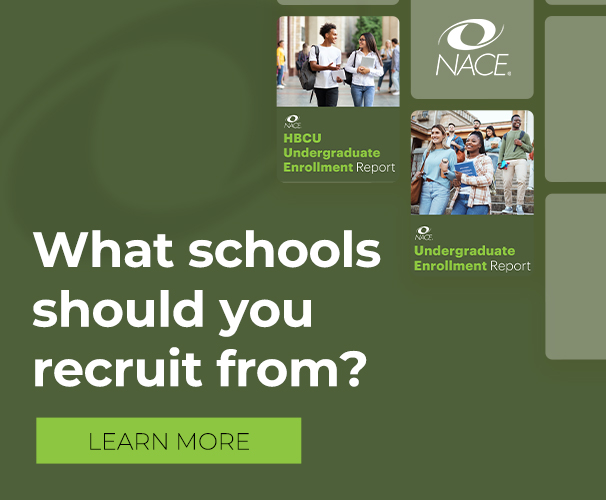Ready, Willing, But Still Underemployed
February 1, 2021 | By David R. Parker and Larry Markle
INDIVIDUALS WITH DISABILITIES
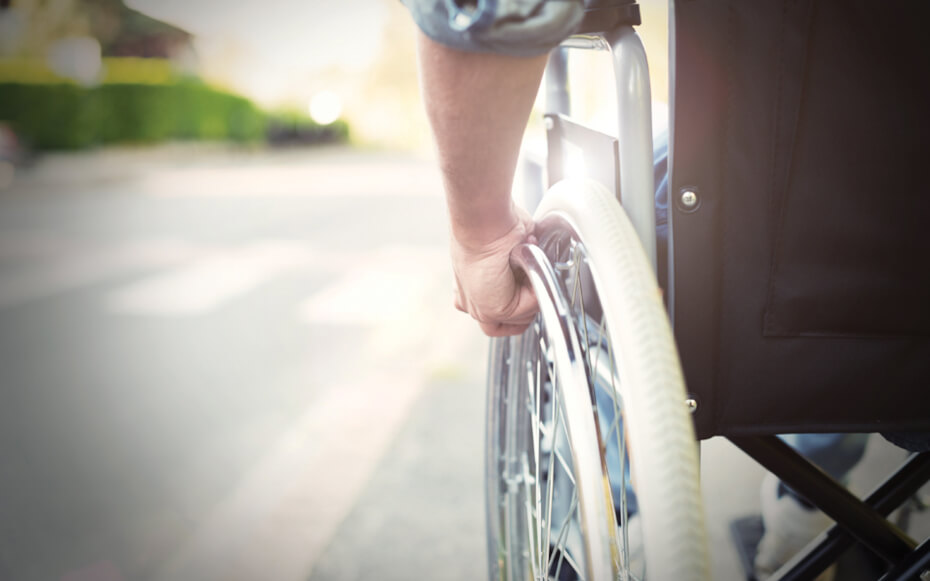
TAGS: diversity and inclusion, journal, students with disabilities,
NACE Journal, February 2021
The powerful relationship between earning a college degree and meaningful employment experiences is firmly established.1 This link is particularly relevant for the 19.4% of college undergraduates who report a disability.2 Under the Americans with Disabilities Amendments Act (ADA-AA), students need to provide documentation to their campus disability services office when registering for accommodations and services. This means that the actual number of undergraduates and graduate students with disabilities is larger than we know, as many of these students choose not to disclose, despite the likelihood of encountering barriers to equal access while participating in higher education.3
All undergraduates benefit from effective preparation in college in order to launch successful careers. Adults with disabilities, however, continue to encounter barriers to meaningful employment even after earning a degree. This is especially true of students with physical disabilities, i.e., mobility, orthopedic, visual, and hearing issues; research indicates that undergraduates with these disabilities account for “9.3% of students with disabilities or approximately 1% of the total population of college students.”4 Individuals with these readily apparent conditions can trigger unconscious uncertainty or even bias during the application and hiring process. According to the Bureau of Labor Statistics (BLS), in 2018, the employment-population ratio was 19.1% among those with a disability compared to 65.9% of those without a disability.5 Evidence-based practices by career services and disability services professionals, coupled with outreach to potential employers, can reverse this trend. This article describes these challenges as well as emerging opportunities provided by the Gregory S. Fehribach Center that target these inequities with potential solutions for college students, campus professionals, and employers.
Challenges to College Graduation
A college degree is a significant predictor of employment success.6 Students with disabilities continue to earn college degrees at lower rates, however, than their non-disabled peers.7, 8 In fact, the National Longitudinal Transition Study-2 (NLTS-2), which compared college completion rates of students with and without disabilities six years after they left high school, noted an overall completion rate of 51.2%, whereas only 38.4% of students with disabilities had completed a degree program.9
Given these educational patterns, it is not surprising that adults with disabilities are employed at significantly lower rates than adults without disabilities.10 This gap begins in high school and has been reported for more than 25 years.11 Research indicates that “youth with disabilities are more likely to drop out of high school, more likely to be unemployed, less likely to pursue postsecondary education, and less likely to live independently.”12 Several factors challenge the ability of students with physical disabilities to obtain a college degree, beginning with systemic barriers as they prepare for college.
Many school systems are ill-prepared to support the college aspirations of students with physical disabilities. High-achieving students with these conditions are often segregated into special education classes in K-12 settings with students with more profound intellectual and developmental disabilities.13 Students with these more significant disabilities are typically not preparing for traditional college experiences or even gainful employment after high school. Data from the NLTS-2 study “indicate that only 6% of students’ transition plans included needed accommodations and supports” for future employment situations.14 One study summarized the nature of these challenges by noting that, “for individuals with disabilities, career development is often complex, nonlinear, and chaotic.”15 This results in many students with physical disabilities leaving high school with alternative diplomas that are not accepted by most colleges.
Another widespread K-12 practice that restricts success in college relates to over-accommodation. As a result, many high school students with physical disabilities experience limited opportunities to learn how to self-advocate. Students have reported that a rigorous college-prep curriculum was modified for them because the school did not know how to provide appropriate accommodations. Additionally, many students report they did not have access to adaptive technology in high school that would allow them to work independently. Consequently, students rely on aides to do work for them or to be assigned tasks with lowered expectations. These patterns diminish students’ self-determination by limiting their opportunities to develop the ability to face challenges in college with a history of having learned how to do so on their own.16
Once in college, further barriers can complicate students’ matriculation efforts. A review of literature undertaken as part of a study of undergraduates with physical disabilities reported generally poorer persistence amongst college students with disabilities.17 A typical statistic noted a 41% rate for students with disabilities compared to 64% for students without reported disabilities. The study was conducted at Ball State University (BSU), which is nationally renowned as a disability-friendly environment with extensive attention to physical access and a highly effective disability services office. Promisingly, the longitudinal analysis of 11,317 BSU students found similar retention and persistence rates among students with and without disabilities.
Several factors influence the graduation patterns of students with physical disabilities: Higher rates were reported by students who used augmentative and alternative communication and pursued training in information technology; in addition, building accessibility remained a significant barrier to persistence in many higher education settings.18 Another study found that students’ levels of autonomy and psychological empowerment also significantly influenced their enrollment in higher education and that “higher levels of self-realization [i.e., self-determination] increase the odds of completing a four-year university program by 2.41 times.”19
Barriers to Successful Career Preparation
Despite a range of systemic barriers, many students with disabilities demonstrate the resilience and grit needed to matriculate into and through higher education. However, they consistently graduate with less employment history than their non-disabled peers. This is critical, as work experience is another key predictor of employment success.20 High school students with disabilities who work consistently achieve higher levels of employment after leaving school.21, 22 Paid work experience, in particular, has a consistently positive influence on post-school employment outcomes for individuals with disabilities.23 In particular, one study found that “community based work experience while youth are still in high school, particularly paid jobs where students work in real workplaces alongside others without disabilities” stood out as a variable that contributed to successful transition to employment.24 Another study yielded similar results, noting that “paid work experience has the most research support among these populations to promote employment success” after school.25 College internships have a similar influence.26 These programs provide undergraduates with physical disabilities networking and authentic job-related experiences that promoted their skill sets and self-confidence.27
Given these findings, what barriers limit the ability of college graduates with physical disabilities to engage in successful career preparation? As noted, one factor is a lower level of work experience. Daily living tasks and academic responsibilities can consume large amounts of time for students with physical disabilities. Time needed to bathe and dress (sometimes only after the arrival of a personal care attendant) and use accessible transportation to campus can be significant. Obtaining and using accessible text and related course materials can also take much longer than the demands on a student without a disability.28
Even when spare time is available, finding part-time employment can be difficult, particularly when economic circumstances limit employment opportunities for everyone. Vocational Rehabilitation (VR), a federal agency designed to enhance employment opportunities for individuals with disabilities, encountered significant funding cutbacks in 2016. Consequently, fewer students today can qualify for VR assistance with finding part-time work in settings where employers are offered guidance, if necessary, in providing job accommodations. Even before the cutbacks, a study published in 2015 found that only 26% of college students with disabilities worked with VR to a “moderate” extent, and 37% only had “minor” involvement. Unfortunately, the same study reported that when students did seek out VR services, the assistance was frequently limited; VR counselors were often primarily aware of only entry-level jobs and had limited training about work experiences for individuals with disabilities.29
Another barrier to employment success for college graduates with disabilities is the challenge of effective self-advocacy in the workplace. Under the ADA-AA, employees with disabilities can request job accommodations (often through human resources). In many cases, college graduates with physical disabilities enter the workforce with limited knowledge about how to do so. One study suggested that college students with learning disabilities may be more focused on the present than on the future; most college students with disabilities in the study reported that they did not use career services, where the issue of accommodations might be raised, until approaching graduation. In addition, the study noted that the disclosure and accommodation process in college and in the workplace were quite different. Further, the study suggested that, despite what many parents and disability service providers assume, “there may be no, or only passing interest, in the role of building skills and understanding the impact and role of accommodations in future employment situations.”30
A third challenge is access to “disability-savvy” career services. Even when students with disabilities use these services, they often report limited satisfaction. This may be due, in part, to challenges that career services professionals encounter in developing disability-specific knowledge and skills. A 2015 study found, for example, that only 26% of two- and four-year campuses provided career services that were targeted to students with disabilities.31 A later study reported problematic differences in career development trends that reflected these needs, noting that, “Upon entering college, students with disabilities may lack vocational awareness compared to their peers... Indeed, college students with disabilities are likely to under-explore their career options compared to their peers; they register with career services and join professional organizations and networks at lower rates... Students perceived a lack of disability-related knowledge among career counselors, and a lack of career-related knowledge among disability services counselors.”32
Given these challenges, researchers have recommended cross training to support collaborations between disability services and career services offices.33 Such services are more helpful when career services staff are knowledgeable about the unique needs of job seekers with disabilities.34 Indeed, research indicates that partnerships between these two campus resources can create the best option for helping students with disabilities obtain internships, which can result in greater self-advocacy skills and a clearer understanding of one’s strengths and weaknesses as an employee.35 NACE promotes these collaborations by including examples from campuses such as UC Berkeley, Ball State University, and University of Pennsylvania on its website.36
Further Barriers in Employment Settings
While employment trends for adults with disabilities have improved, particularly for those with a college degree, statistics portray ongoing discrepancies compared to non-disabled adults. BLS noted an employment-population ratio of 19.1% among adults with disabilities in 2018 compared to 65.9% for those without a disability.37 Another study found that adults with “ambulatory” disabilities (defined as having difficulty walking or climbing stairs) were only employed at a rate of 15.4%.38
Numerous factors help to explain these trends. After obtaining a job, many employees with disabilities lack accurate information about their accommodations needs and how to obtain them. A 2006 study concluded that “college graduates with disabilities who do obtain employment after graduation experience significant problems obtaining on-the-job accommodations, planning their next career steps, and maintaining employment over time.”39 These concerns persist a generation later: A 2019 study found significant gaps in college graduates’ ability to “determine their need for accommodation, navigate disclosure conversations, be knowledgeable about disability law, and generally be prepared to contend with employers who may be hesitant to hire individuals with disabilities.”40
In studying these trends, researchers have also examined the perspectives of employers. A 2012 study reported employers’ concerns about hiring individuals with disabilities due to their lack of workplace competencies: Those employers valued “interpersonal skills and social skills such as dependability, accepting authority, getting along with people, and persistence.”41 They added that the most valued skills fell in areas of employee attitudes, communication, and basic knowledge. The highest rated attitudes were dependability, staying with a task, getting along with others, and recognizing the importance of good health. The authors raised the question, however, of employer attitudes and misperceptions that were not linked to actual experience. “One of the major obstacles [to employment] is employers’ concerns about, and misconceptions of, work-related skills and work-related personality attributes.”42 A separate study identified the top five skills that employers looked for in successful employees with disabilities. These included “demonstrating personal integrity/honesty in work, ability to follow instructions, ability to show respect for others, ability to be on time, and ability to show high regard for safety procedures.”43 These findings speak to the skills and dispositions that college students with disabilities strengthen through work experiences such as internships.
Other factors complicate the ability of college graduates with disabilities to get hired and flourish in careers. Key examples include housing, transportation, attendant care, and the financial implications that work has on benefits that individuals with physical disabilities may receive. While finding adequate housing can be a concern for anyone who accepts a new job, this challenge presents added layers of complexity to someone with a physical disability. For a wheelchair user, finding accessible housing is difficult. Most homes are not built with wheelchair accessibility in mind, and retrofitting houses and apartments to create access can be very expensive. When accessible housing can be found, it is often too expensive for a recent college graduate to afford. Due to the lack of accessible housing, students with physical disabilities often do not have the luxury of sharing living space with friends or colleagues.
Even when accessible housing can be obtained, the next concern is transportation to and from work. For many individuals with mobility and visual disabilities who are unable to drive, reliable public transportation is vital.44 If the residence is not on or close to an established public transit route, other options need to be explored. Some cities offer para-transit for people with disabilities, but, in most situations, these rides require making arrangements at least 24 hours in advance and cannot guarantee exact pick-up times. Individuals with disabilities are often given a two-hour window in which they may be picked up. While ride-sharing services such as Uber or Lyft may be an option for some, very few of these vehicles offer accessibility for wheelchair users.
For students with physical disabilities who rely on others to assist with activities of daily living such as getting in and out of bed, getting dressed, bathing, and toileting, finding reliable attendant care can be difficult as well. Such challenges could complicate the individual’s successful transition to career opportunities later.45 In addition, there are difficulties in coordinating care from various adult service agencies.46 Multiple studies describe occasions in which care providers have been unreliable and left the individual with a physical disability unprepared for work.47, 48
A final and critical barrier relates to governmental benefits to pay for attendant care. These benefits include a cap on the amount of income individuals can receive from being employed. Thus, many college graduates with physical disabilities choose not to work, work part time, or take jobs below their educational level.49
Connecting Campuses, Students, and Employers
The Gregory S. Fehribach Center at Eskenazi Health (Indianapolis) was created to work with college students with physical disabilities, campus professionals, and employers to close many of the gaps reported in the literature. The Fehribach Center offers eight-week internships in the summer, with limited opportunities also available in the fall and spring. These are paid, full-time internships in fields related to the student’s major, with housing and transportation assistance offered when needed.
The roots of the Fehribach Center are at Ball State University.50 As a result of its commitment to accessibility, the university has consistently enrolled a large number of students with physical disabilities. While Ball State researchers found that its undergraduates with physical disabilities were graduating at rates similar to their peers without disabilities, these students often then struggled to find equitable employment.51 This disconnect led Ball State alumnus and Indianapolis attorney Greg Fehribach (himself a wheelchair user) to initiate an internship program. His vision was to close this college/employment gap in Indiana and throughout the United States, knowing that internships are a critical tool in helping students gain the skills, knowledge, and experience necessary to succeed in the workplace.
This program began when one Ball State student interned in 2011 at Eskenazi Health. The program has grown rapidly since then, underscoring its need. To date, 101 students have participated in 184 internships. These students have attended 30 colleges and universities and interned for 18 participating employers including BraunAbility, Chase Bank, Christel House International, Conexus, Cummins, Eli Lilly and Company, Eskenazi Health, Health and Science Innovations, the Indianapolis Children’s Museum, Lumina Foundation, Old National Bank, and the State of Indiana.
Any student with a physical disability attending college in Indiana is eligible to apply for a Fehribach Center internship. Additionally, students who reside in Indiana but attend college out of state are welcome to apply. Students from all fields of study are encouraged to apply.
Fehribach Center staff visit every college campus in Indiana each fall to meet with students, faculty, and professionals in career services and disability services to provide information and build relationships. Eskenazi Health’s numerous departments and operations, coupled with a wide range of additional corporate and government partners, allow Fehribach Center staff to find relevant matches for students regardless of their academic majors.
In addition to the paid work experience, the Fehribach Center provides additional services and programs to all interns, including housing, transportation, professional development workshops and events, and disability accommodations.
Fehribach Center interns have enjoyed very positive outcomes. Over 90% have graduated and are employed, have graduated and are in graduate school, or are actively matriculating toward graduation. Eskenazi Health, Eli Lilly and Company, and BraunAbility have hired former Fehribach Center interns for full-time positions.
In addition to programming for interns, the Fehribach Center offers resources to key stakeholders, such as employers and Indiana colleges and universities. Each employer partner that hosts an intern receives training on best practices in employing individuals with disabilities. This includes information on reasonable accommodations and related responsibilities under the ADA-AA. On an annual basis, staff members from career services and disability services from Indiana postsecondary institutions are invited to “lunch-n-learns.” These gatherings help strengthen critical partnerships, provide updates on the Center’s activities and growth, allow interns to share their experiences, and provide information from a growing base of evidence-based practices.
Roger Wessel, Ph.D., professor emeritus of higher education at BSU and former executive editor of the Journal of Postsecondary Education and Disability, is the Fehribach Center’s external evaluator. Dr. Wessel developed assessment instruments for interns and their supervisors/co-workers, which he uses to conduct annual evaluations. In 2020, 42 interns and 45 supervisors/coworkers completed the assessments. Key findings from include:
- Students completing their first internship with the Fehribach Center (45.7% of the respondents) reported higher levels of autonomy and self-determination, professional development, and empowerment for career readiness after completing the internship. As one intern wrote, “For the first time, I have been able to use my talent in many ways to discover myself and impact the people around me.”
- Interns completing their second, third, or fourth internship with the Fehribach Center (54.3% of the respondents) reported being more confident in their abilities to control their destinies and being able to network by professionally interacting with others on work interests.
- Overall, all interns reported a “very high” level of satisfaction with the quality of their internships. After an initial internship, one noted, “Three months ago, I looked at the future with unease and measured anxiety. Now, I look to the future with optimism and measured confidence.”
- Both new and returning interns reported feeling they were able to perform their internship duties well. This outcome was reflected in this intern’s comment: “This internship has allowed me to prove to myself—and everyone else—that I can have a career and be successful. For the first time, I really feel like the possibilities are endless.”
- Supervisors reported that their interns performed their duties well. One supervisor described a positive mentoring relationship this way: “The mission of opening eyes and gaining better understanding was certainly accomplished. More importantly I think he gained valuable professional exposure and experience that he'll be able to reference and draw on for the future.”
- Supervisors and co-workers reported a high level of comfort working alongside individuals with physical disabilities. One supervisor wrote, “It's an opportunity for my team members to coach, educate, and manage others. Most importantly, it allows myself and my team to continue to learn how to best work with individuals with disabilities and provides the intern with valuable job experience they can use on their resume.”
- Supervisors and co-workers reported that they believed their workplace was accessible and inclusive for interns, both in terms of physical and technological access. As one employer noted, “It helped me to grow in my leadership style and skill set to adapt my practices, presentations, and documentations in a more inclusive way. I grew in my knowledge and my appreciation for working with a person with a visual impairment.”
Recommendations and Next Steps
While progress is unfolding, there is still much work to be done to reduce barriers and increase opportunities so that highly qualified college graduates with physical disabilities have an equitable seat at the employment table. Strategic partnerships between career services and disability services professionals, employers, and community partners, such as the Gregory S. Fehribach Center, hold exciting promise for offering undergraduates equal opportunities to develop the skills, knowledge, and work experiences needed to launch successful careers. In time, these efforts can increase the graduation and gainful employment rates of a growing population. Fehribach Center staff look forward to the following collaborative next steps.
- We will continue recruiting qualified students to engage in the internship program and evaluate their experiences and outcomes. The Fehribach Center has witnessed robust growth in its early stages of operation and looks forward to expanding its partnership with Indiana employers that wish to host interns. The Center is developing plans to enhance its partnerships with career services and disability services professionals on Indiana campuses to promote cross-training opportunities. These initiatives will be designed to increase students’ access to work experiences in college and receive targeted career development that strengthens their ability to succeed in the workplace with or without accommodations. This approach is recommended by the National Council on Disability.52
- Staff will continue learning about and improving participants’ internship experiences via annual external evaluations. Additionally, we will support research about the employment experiences of college graduates with physical disabilities and the efficacy of the Center’s programming. In 2020, the Fehribach Center created a national Research Advisory Board (RAB). This group of scholars from multiple U.S. campuses specializes in research on evidence-based practices that promote self-determination in students with disabilities, often with a focus on employment outcomes. In its initial year, the Center funded three research studies to be conducted in 2021 by RAB members. This group will continue to participate in an annual research symposium, and its members anticipate publishing articles and making presentations as professional conferences about their findings regarding the Center’s work.
- We will begin networking with Indiana high schools in 2021, with the goal of offering educational programming and support. Curriculum and workshops will be developed to teach all students about people with disabilities and the history of this community’s civil rights efforts as an important aspect of cultural diversity. In addition, we will provide high school students with physical disabilities access to information, role models, and encouragement to pursue college and engage in work experiences such as college internships.
- As evaluative data and research findings provide objective evidence of the impact of the Fehribach Center programming, staff will share findings and recommendations with government policy leaders who shape employment legislation and practices.
- In time, should evaluative data and research findings support the development of evidence-based practices at the Center, the staff will also reach out to other stakeholders who may have an interest in replicating this model in different regions of the country.
Endnotes
1 Vilorio, D. (2016, March). Education matters. Career Outlook, U.S. Bureau of Labor Statistics. Retrieved from https://www.bls.gov/careeroutlook/2016/data-on-display/education-matters.htm.
2 National Center for Education (2017). Disability rates and employment status by educational attainment. Retrieved from https://nces.ed.gov/programs/coe/indicator_tad.asp.
3 Grimes, S., Southgate, E., Scevak, J., & Buchanan, R. (2020). University student experiences of disability and the influence of stigma on institutional non-disclosure and learning. Journal of Postsecondary Education and Disability, 33(1), 23-37.
4 Gelbar, N.W., Madaus, J.W., Lombardi, Al, Faggella-Luby, M., & Dukes, L. (2015). College students with physical disabilities: Common on campus, uncommon in the literature. Physical Disabilities: Education and Related Services, 34(2), 14-31.
5 Bureau of Labor Statistics (2019). Persons with a disability: Labor force characteristics – 2018. Retrieved from www.bls.gov/news.release/pdf/disabl/pdf.
6 Oswald, G.R., Huber, M.J., & Bonza, A. (2015). Effective job-seeking preparation and employment services for college students with disabilities. Journal of Postsecondary Education and Disability, 28(3), 375-382.
7 Lombardi, A., Dukes, L.L., & Petcu, S. (2019). Introduction to the special issue on postsecondary preparation for students with disabilities. Career Development and Transition for Exceptional Individuals, 42(1), 3-5.
8 Bureau of Labor Statistics (2019). Persons with a disability: Labor force characteristics – 2018. U.S. Department of Labor. Retrieved from www.bls.gov/news.release/pdf/disabl.pdf .
9 Sanford, C., Newman, L., Wagner, M., Cameto, R., Knokey, A. M., & Shaver, D. (2011). The Post-High School Outcomes of Young Adults with Disabilities Up to 6 Years After High School: Key Findings from the National Longitudinal Transition Study-2 (NLTS2) (NCSER 2011-3004). Menlo Park, CA: SRI International. Retrieved from https://ies.ed.gov/ncser/pubs/20113004/pdf/20113004.pdf.
10 Targett, P., Wehman, P., West, M. Dillard., C., & Cifu, G. (2013). Promoting transition to adulthood for youth with physical disabilities and health impairments. Journal of Vocational Rehabilitation, 39, 229- 239.
11 Mamun, A.A., Carter, E.W., Fraker, T.M., & Timmins, L.L. (2018). Impact of early work experiences on subsequent paid employment for young adults with disabilities. Career Development for Exceptional Individuals, 41(4), 212-222.
12 Prince, A.M.T., Hodge, J, Bridges, W.C., & Katsiyannis, A. (2018). Predictors of postschool education/training and employment outcomes for youth with disabilities. Career Development and Transition for Exceptional Individuals, 41(2), 77-87.
13 Wessel, R.D., Jones, D.L., Blanch, C.L., & Markle, L. (2015). Pre-enrollment considerations of undergraduate wheelchair users and their post-enrollment transitions. Journal of Postsecondary Education and Disability, 28(1), 57-71.
14 Wagner, M., Newman, L., Cameto, R., Levine, P, and Garza, N. (2006). An Overview of Findings From Wave 2 of the National Longitudinal Transition Study-2 (NLTS2). Menlo Park, CA: SRI International. Retrieved from www.nlts2.org/reports/2006_08/nlts2_report_2006_08_complete.pdf.
15 Lindstrom, L.E., Benz, M.R., & Doren, B. (2004). Expanding career options for young women with learning disabilities. Career Development for Exceptional Individuals, 27(1), 43-63.
16 Gelbar, N., Madaus, J., Dukes, L., Fagella-Luby, M., Volk, D., & Monahan, J. (2019). Self-
determination and college students with disabilities: Research trends and construct measurement. Journal of Student Affairs Research and Practice, 57, 1-19.
17 Wessel et al. (2015).
18 Gelbar et al. (2015).
19 Petcu, S.D., Van Horn, M.L., & Shogren, K.A. (2017). Self-determination and the enrollment in and completion of postsecondary education for students with disabilities. Career Development for Exceptional Individuals, 40(4), 225-234.
20 Cmar, J.L., McDonnall, M.C., & Markoski, K.M., (2018). In-school predictors of postschool employment for youth who are deaf-blind. Career Development and Transition for Exceptional Individuals, 41(4), 223-233.
21 Burnes, J.J., Martin, J.E., Terry, R., McConnell, A.E., & Hennessey, M.H. (2018). Predicting postsecondary education and employment outcomes using results from the transition assessment and goal generator. Career Development and Transition for Exceptional Individuals, 41(2), 111-121.
22 Grigal, M., Papay, C., Smith, F., Hart, D., & Verbeck, R. (2019). Experiences that predict employment for students with intellectual and developmental disabilities in federally funded higher education programs. Career Development and Transition for Exceptional Individuals, 42(1), 17-28.
23 Mazzotti, V.L., Rowe, D.A., Sinclair, J., Poppen, M., Woods, W.E., & Shearer, M.L. (2016). Predictors of post-school success: A systemic review of NLTS2 secondary analyses. Career Development for Exceptional Individuals, 39(4), 196-215.
24 Targett, et. al. (2013).
25 Cmar, et. al. (2018).
26 Madaus, J.W. (2006). Improving transition to career for college students with learning
disabilities: Suggestions from graduates. Journal of Postsecondary Education and Disability, 19(1), 85-93.
27 DiYenno, C., Mulvihill, T., Wessel, R.D., & Markle, L. (2019). Experience of students with physical disabilities in a summer internship program. Journal of Postsecondary Education and Disability, 32(2), 147-157.
28 Pillette, K. (2019). College students with disabilities and employment: Career development needs and models of support. NCCSD Research Brief, 2(3). Huntersville, NC: National Center for College Students with Disabilities, Association on Higher Education and Disability. http://www.NCCSDclearninghouse.org.
29 Oswald et. al. (2015).
30 Madaus (2006).
31 Oswald et. al. (2015).
32 Pillette (2019), p. 4.
33 Madaus (2006).
34 DiYenno et. al. (2019).
35 Mamun et. al. (2018).
36 National Association of Colleges and Employers (2019). Students with disabilities: Career services best practices. Retrieved from www.naceweb.org/diversity-equity-and-inclusion/individuals-with-disabilities/students-with-disabilities-career-services-best-practices/.
37 Bureau of Labor Statistics (2019).
38 Erickson, W., Lee, C., & von Schrader, S. (2018). 2016 Disability Status Report: United States. Ithaca, NY: Cornell University Yang-Tan Institute on Employment and Disability. Retrieved from www.disabilitystatistics.org/StatusReports/2016-PDF/2016-StatusReport_US.pdf.
39 Hennessey, M.L., Roessler, R., Cook, B., Unger, D., & Rumrill, P. (2006). Employment and career development concerns of postsecondary students with disabilities: Service and policy implications. Journal of Postsecondary Education and Disability, 19(1), 39-55.
40 Pillette (2019), p. 4.
41 Ju, S., Zhang, D., Pacha, J. (2012). Employability skills valued by employers as important for entry-level employees with and without disabilities. Career Development and Transition for Exceptional Individuals, 35(1), 29-38.
42 Ju et al. (2012), p. 29.
43 Pingry O’Neill, L.N., Markward, M.J., & French, J.P. (2012). Predictors of graduation among college students with disabilities. Journal of Postsecondary Education and Disability, 25(1), 21-36.
44 Cmar et. al. (2018).
45 Wessel et. al. (2015).
46 Cmar et. al. (2018).
47 Burwell, N.R., Wessel, R.D., & Mulvihill, T. (2015). Attendant care for college students with
physical disabilities using wheelchairs: Transition issues and experiences. Journal of Postsecondary Education and Disability, 28(3), 293-307.
48 DiYenno et. al. (2019).
49 Mathur, A. (2016). Poor work incentives in disability: What to do. Forbes. Retrieved from www.forbes.com/sites/aparnamathur/2016/09/22/poor-work-incentives-in-disability-what-to-do/?sh=197621993a14.
50 Gilmer, T. (2020). Wheels on campus: A guide to wheelchair-friendly higher education. New Mobility. Retrieved from www.newmobility.com/wheels-on-campus/.
51 Wessel et. al. (2015).
52 National Council on Disability (2017). National Disability Policy: A Progress Report, p. 46.
 David R. Parker, Ph.D.,is a postsecondary disability specialist and ADD/life coach at CRG (Children’s Resource Group) in Indianapolis, Indiana. Previously, he served as director of a private school for students with dyslexia, administrator of LD/ADHD programs at University of North Carolina - Chapel Hill and University of Connecticut, and program manager of a National Science Foundation STEM/UDI grant project at Washington University in St. Louis. He has conducted training on best practices for college students with ADHD, LD, and ASD in Italy, Japan, Austria, and Kuwait. Dr. Parker is also the research coordinator for the Gregory S. Fehribach Center. In this role, he coordinates partnerships between center staff and members of its national research advisory board to study the impact of paid internships on the career outcomes of college students with physical disabilities.
David R. Parker, Ph.D.,is a postsecondary disability specialist and ADD/life coach at CRG (Children’s Resource Group) in Indianapolis, Indiana. Previously, he served as director of a private school for students with dyslexia, administrator of LD/ADHD programs at University of North Carolina - Chapel Hill and University of Connecticut, and program manager of a National Science Foundation STEM/UDI grant project at Washington University in St. Louis. He has conducted training on best practices for college students with ADHD, LD, and ASD in Italy, Japan, Austria, and Kuwait. Dr. Parker is also the research coordinator for the Gregory S. Fehribach Center. In this role, he coordinates partnerships between center staff and members of its national research advisory board to study the impact of paid internships on the career outcomes of college students with physical disabilities.
 Larry Markle is the director of the Gregory S. Fehribach Center at Eskenazi Health in Indianapolis, a program that provides college students with physical disabilities with paid internships in fields related to their major and professional development training to improve employment outcomes. Prior to that, Markle was the director of disability services at Ball State University for 13 years. During his tenure, Ball State was recognized nationally as a leader in physical accessibility for students with disabilities. A 2019 recipient of the Association on Higher Education and Disability’s Meritorious Contribution Award, Markle has co-authored multiple articles on disability and higher education that have been published in peer reviewed journals and presented at dozens of regional and national conferences. He can be reached by email at larry.markle@eskenazihealth.edu.
Larry Markle is the director of the Gregory S. Fehribach Center at Eskenazi Health in Indianapolis, a program that provides college students with physical disabilities with paid internships in fields related to their major and professional development training to improve employment outcomes. Prior to that, Markle was the director of disability services at Ball State University for 13 years. During his tenure, Ball State was recognized nationally as a leader in physical accessibility for students with disabilities. A 2019 recipient of the Association on Higher Education and Disability’s Meritorious Contribution Award, Markle has co-authored multiple articles on disability and higher education that have been published in peer reviewed journals and presented at dozens of regional and national conferences. He can be reached by email at larry.markle@eskenazihealth.edu.
NACE Journal, February 2021
The powerful relationship between earning a college degree and meaningful employment experiences is firmly established.1 This link is particularly relevant for the 19.4% of college undergraduates who report a disability.2 Under the Americans with Disabilities Amendments Act (ADA-AA), students need to provide documentation to their campus disability services office when registering for accommodations and services. This means that the actual number of undergraduates and graduate students with disabilities is larger than we know, as many of these students choose not to disclose, despite the likelihood of encountering barriers to equal access while participating in higher education.3
All undergraduates benefit from effective preparation in college in order to launch successful careers. Adults with disabilities, however, continue to encounter barriers to meaningful employment even after earning a degree. This is especially true of students with physical disabilities, i.e., mobility, orthopedic, visual, and hearing issues; research indicates that undergraduates with these disabilities account for “9.3% of students with disabilities or approximately 1% of the total population of college students.”4 Individuals with these readily apparent conditions can trigger unconscious uncertainty or even bias during the application and hiring process. According to the Bureau of Labor Statistics (BLS), in 2018, the employment-population ratio was 19.1% among those with a disability compared to 65.9% of those without a disability.5 Evidence-based practices by career services and disability services professionals, coupled with outreach to potential employers, can reverse this trend. This article describes these challenges as well as emerging opportunities provided by the Gregory S. Fehribach Center that target these inequities with potential solutions for college students, campus professionals, and employers.
Challenges to College Graduation
A college degree is a significant predictor of employment success.6 Students with disabilities continue to earn college degrees at lower rates, however, than their non-disabled peers.7, 8 In fact, the National Longitudinal Transition Study-2 (NLTS-2), which compared college completion rates of students with and without disabilities six years after they left high school, noted an overall completion rate of 51.2%, whereas only 38.4% of students with disabilities had completed a degree program.9
Given these educational patterns, it is not surprising that adults with disabilities are employed at significantly lower rates than adults without disabilities.10 This gap begins in high school and has been reported for more than 25 years.11 Research indicates that “youth with disabilities are more likely to drop out of high school, more likely to be unemployed, less likely to pursue postsecondary education, and less likely to live independently.”12 Several factors challenge the ability of students with physical disabilities to obtain a college degree, beginning with systemic barriers as they prepare for college.
Many school systems are ill-prepared to support the college aspirations of students with physical disabilities. High-achieving students with these conditions are often segregated into special education classes in K-12 settings with students with more profound intellectual and developmental disabilities.13 Students with these more significant disabilities are typically not preparing for traditional college experiences or even gainful employment after high school. Data from the NLTS-2 study “indicate that only 6% of students’ transition plans included needed accommodations and supports” for future employment situations.14 One study summarized the nature of these challenges by noting that, “for individuals with disabilities, career development is often complex, nonlinear, and chaotic.”15 This results in many students with physical disabilities leaving high school with alternative diplomas that are not accepted by most colleges.
Another widespread K-12 practice that restricts success in college relates to over-accommodation. As a result, many high school students with physical disabilities experience limited opportunities to learn how to self-advocate. Students have reported that a rigorous college-prep curriculum was modified for them because the school did not know how to provide appropriate accommodations. Additionally, many students report they did not have access to adaptive technology in high school that would allow them to work independently. Consequently, students rely on aides to do work for them or to be assigned tasks with lowered expectations. These patterns diminish students’ self-determination by limiting their opportunities to develop the ability to face challenges in college with a history of having learned how to do so on their own.16
Once in college, further barriers can complicate students’ matriculation efforts. A review of literature undertaken as part of a study of undergraduates with physical disabilities reported generally poorer persistence amongst college students with disabilities.17 A typical statistic noted a 41% rate for students with disabilities compared to 64% for students without reported disabilities. The study was conducted at Ball State University (BSU), which is nationally renowned as a disability-friendly environment with extensive attention to physical access and a highly effective disability services office. Promisingly, the longitudinal analysis of 11,317 BSU students found similar retention and persistence rates among students with and without disabilities.
Several factors influence the graduation patterns of students with physical disabilities: Higher rates were reported by students who used augmentative and alternative communication and pursued training in information technology; in addition, building accessibility remained a significant barrier to persistence in many higher education settings.18 Another study found that students’ levels of autonomy and psychological empowerment also significantly influenced their enrollment in higher education and that “higher levels of self-realization [i.e., self-determination] increase the odds of completing a four-year university program by 2.41 times.”19
Barriers to Successful Career Preparation
Despite a range of systemic barriers, many students with disabilities demonstrate the resilience and grit needed to matriculate into and through higher education. However, they consistently graduate with less employment history than their non-disabled peers. This is critical, as work experience is another key predictor of employment success.20 High school students with disabilities who work consistently achieve higher levels of employment after leaving school.21, 22 Paid work experience, in particular, has a consistently positive influence on post-school employment outcomes for individuals with disabilities.23 In particular, one study found that “community based work experience while youth are still in high school, particularly paid jobs where students work in real workplaces alongside others without disabilities” stood out as a variable that contributed to successful transition to employment.24 Another study yielded similar results, noting that “paid work experience has the most research support among these populations to promote employment success” after school.25 College internships have a similar influence.26 These programs provide undergraduates with physical disabilities networking and authentic job-related experiences that promoted their skill sets and self-confidence.27
Given these findings, what barriers limit the ability of college graduates with physical disabilities to engage in successful career preparation? As noted, one factor is a lower level of work experience. Daily living tasks and academic responsibilities can consume large amounts of time for students with physical disabilities. Time needed to bathe and dress (sometimes only after the arrival of a personal care attendant) and use accessible transportation to campus can be significant. Obtaining and using accessible text and related course materials can also take much longer than the demands on a student without a disability.28
Even when spare time is available, finding part-time employment can be difficult, particularly when economic circumstances limit employment opportunities for everyone. Vocational Rehabilitation (VR), a federal agency designed to enhance employment opportunities for individuals with disabilities, encountered significant funding cutbacks in 2016. Consequently, fewer students today can qualify for VR assistance with finding part-time work in settings where employers are offered guidance, if necessary, in providing job accommodations. Even before the cutbacks, a study published in 2015 found that only 26% of college students with disabilities worked with VR to a “moderate” extent, and 37% only had “minor” involvement. Unfortunately, the same study reported that when students did seek out VR services, the assistance was frequently limited; VR counselors were often primarily aware of only entry-level jobs and had limited training about work experiences for individuals with disabilities.29
Another barrier to employment success for college graduates with disabilities is the challenge of effective self-advocacy in the workplace. Under the ADA-AA, employees with disabilities can request job accommodations (often through human resources). In many cases, college graduates with physical disabilities enter the workforce with limited knowledge about how to do so. One study suggested that college students with learning disabilities may be more focused on the present than on the future; most college students with disabilities in the study reported that they did not use career services, where the issue of accommodations might be raised, until approaching graduation. In addition, the study noted that the disclosure and accommodation process in college and in the workplace were quite different. Further, the study suggested that, despite what many parents and disability service providers assume, “there may be no, or only passing interest, in the role of building skills and understanding the impact and role of accommodations in future employment situations.”30
A third challenge is access to “disability-savvy” career services. Even when students with disabilities use these services, they often report limited satisfaction. This may be due, in part, to challenges that career services professionals encounter in developing disability-specific knowledge and skills. A 2015 study found, for example, that only 26% of two- and four-year campuses provided career services that were targeted to students with disabilities.31 A later study reported problematic differences in career development trends that reflected these needs, noting that, “Upon entering college, students with disabilities may lack vocational awareness compared to their peers... Indeed, college students with disabilities are likely to under-explore their career options compared to their peers; they register with career services and join professional organizations and networks at lower rates... Students perceived a lack of disability-related knowledge among career counselors, and a lack of career-related knowledge among disability services counselors.”32
Given these challenges, researchers have recommended cross training to support collaborations between disability services and career services offices.33 Such services are more helpful when career services staff are knowledgeable about the unique needs of job seekers with disabilities.34 Indeed, research indicates that partnerships between these two campus resources can create the best option for helping students with disabilities obtain internships, which can result in greater self-advocacy skills and a clearer understanding of one’s strengths and weaknesses as an employee.35 NACE promotes these collaborations by including examples from campuses such as UC Berkeley, Ball State University, and University of Pennsylvania on its website.36
Further Barriers in Employment Settings
While employment trends for adults with disabilities have improved, particularly for those with a college degree, statistics portray ongoing discrepancies compared to non-disabled adults. BLS noted an employment-population ratio of 19.1% among adults with disabilities in 2018 compared to 65.9% for those without a disability.37 Another study found that adults with “ambulatory” disabilities (defined as having difficulty walking or climbing stairs) were only employed at a rate of 15.4%.38
Numerous factors help to explain these trends. After obtaining a job, many employees with disabilities lack accurate information about their accommodations needs and how to obtain them. A 2006 study concluded that “college graduates with disabilities who do obtain employment after graduation experience significant problems obtaining on-the-job accommodations, planning their next career steps, and maintaining employment over time.”39 These concerns persist a generation later: A 2019 study found significant gaps in college graduates’ ability to “determine their need for accommodation, navigate disclosure conversations, be knowledgeable about disability law, and generally be prepared to contend with employers who may be hesitant to hire individuals with disabilities.”40
In studying these trends, researchers have also examined the perspectives of employers. A 2012 study reported employers’ concerns about hiring individuals with disabilities due to their lack of workplace competencies: Those employers valued “interpersonal skills and social skills such as dependability, accepting authority, getting along with people, and persistence.”41 They added that the most valued skills fell in areas of employee attitudes, communication, and basic knowledge. The highest rated attitudes were dependability, staying with a task, getting along with others, and recognizing the importance of good health. The authors raised the question, however, of employer attitudes and misperceptions that were not linked to actual experience. “One of the major obstacles [to employment] is employers’ concerns about, and misconceptions of, work-related skills and work-related personality attributes.”42 A separate study identified the top five skills that employers looked for in successful employees with disabilities. These included “demonstrating personal integrity/honesty in work, ability to follow instructions, ability to show respect for others, ability to be on time, and ability to show high regard for safety procedures.”43 These findings speak to the skills and dispositions that college students with disabilities strengthen through work experiences such as internships.
Other factors complicate the ability of college graduates with disabilities to get hired and flourish in careers. Key examples include housing, transportation, attendant care, and the financial implications that work has on benefits that individuals with physical disabilities may receive. While finding adequate housing can be a concern for anyone who accepts a new job, this challenge presents added layers of complexity to someone with a physical disability. For a wheelchair user, finding accessible housing is difficult. Most homes are not built with wheelchair accessibility in mind, and retrofitting houses and apartments to create access can be very expensive. When accessible housing can be found, it is often too expensive for a recent college graduate to afford. Due to the lack of accessible housing, students with physical disabilities often do not have the luxury of sharing living space with friends or colleagues.
Even when accessible housing can be obtained, the next concern is transportation to and from work. For many individuals with mobility and visual disabilities who are unable to drive, reliable public transportation is vital.44 If the residence is not on or close to an established public transit route, other options need to be explored. Some cities offer para-transit for people with disabilities, but, in most situations, these rides require making arrangements at least 24 hours in advance and cannot guarantee exact pick-up times. Individuals with disabilities are often given a two-hour window in which they may be picked up. While ride-sharing services such as Uber or Lyft may be an option for some, very few of these vehicles offer accessibility for wheelchair users.
For students with physical disabilities who rely on others to assist with activities of daily living such as getting in and out of bed, getting dressed, bathing, and toileting, finding reliable attendant care can be difficult as well. Such challenges could complicate the individual’s successful transition to career opportunities later.45 In addition, there are difficulties in coordinating care from various adult service agencies.46 Multiple studies describe occasions in which care providers have been unreliable and left the individual with a physical disability unprepared for work.47, 48
A final and critical barrier relates to governmental benefits to pay for attendant care. These benefits include a cap on the amount of income individuals can receive from being employed. Thus, many college graduates with physical disabilities choose not to work, work part time, or take jobs below their educational level.49
Connecting Campuses, Students, and Employers
The Gregory S. Fehribach Center at Eskenazi Health (Indianapolis) was created to work with college students with physical disabilities, campus professionals, and employers to close many of the gaps reported in the literature. The Fehribach Center offers eight-week internships in the summer, with limited opportunities also available in the fall and spring. These are paid, full-time internships in fields related to the student’s major, with housing and transportation assistance offered when needed.
The roots of the Fehribach Center are at Ball State University.50 As a result of its commitment to accessibility, the university has consistently enrolled a large number of students with physical disabilities. While Ball State researchers found that its undergraduates with physical disabilities were graduating at rates similar to their peers without disabilities, these students often then struggled to find equitable employment.51 This disconnect led Ball State alumnus and Indianapolis attorney Greg Fehribach (himself a wheelchair user) to initiate an internship program. His vision was to close this college/employment gap in Indiana and throughout the United States, knowing that internships are a critical tool in helping students gain the skills, knowledge, and experience necessary to succeed in the workplace.
This program began when one Ball State student interned in 2011 at Eskenazi Health. The program has grown rapidly since then, underscoring its need. To date, 101 students have participated in 184 internships. These students have attended 30 colleges and universities and interned for 18 participating employers including BraunAbility, Chase Bank, Christel House International, Conexus, Cummins, Eli Lilly and Company, Eskenazi Health, Health and Science Innovations, the Indianapolis Children’s Museum, Lumina Foundation, Old National Bank, and the State of Indiana.
Any student with a physical disability attending college in Indiana is eligible to apply for a Fehribach Center internship. Additionally, students who reside in Indiana but attend college out of state are welcome to apply. Students from all fields of study are encouraged to apply.
Fehribach Center staff visit every college campus in Indiana each fall to meet with students, faculty, and professionals in career services and disability services to provide information and build relationships. Eskenazi Health’s numerous departments and operations, coupled with a wide range of additional corporate and government partners, allow Fehribach Center staff to find relevant matches for students regardless of their academic majors.
In addition to the paid work experience, the Fehribach Center provides additional services and programs to all interns, including housing, transportation, professional development workshops and events, and disability accommodations.
Fehribach Center interns have enjoyed very positive outcomes. Over 90% have graduated and are employed, have graduated and are in graduate school, or are actively matriculating toward graduation. Eskenazi Health, Eli Lilly and Company, and BraunAbility have hired former Fehribach Center interns for full-time positions.
In addition to programming for interns, the Fehribach Center offers resources to key stakeholders, such as employers and Indiana colleges and universities. Each employer partner that hosts an intern receives training on best practices in employing individuals with disabilities. This includes information on reasonable accommodations and related responsibilities under the ADA-AA. On an annual basis, staff members from career services and disability services from Indiana postsecondary institutions are invited to “lunch-n-learns.” These gatherings help strengthen critical partnerships, provide updates on the Center’s activities and growth, allow interns to share their experiences, and provide information from a growing base of evidence-based practices.
Roger Wessel, Ph.D., professor emeritus of higher education at BSU and former executive editor of the Journal of Postsecondary Education and Disability, is the Fehribach Center’s external evaluator. Dr. Wessel developed assessment instruments for interns and their supervisors/co-workers, which he uses to conduct annual evaluations. In 2020, 42 interns and 45 supervisors/coworkers completed the assessments. Key findings from include:
- Students completing their first internship with the Fehribach Center (45.7% of the respondents) reported higher levels of autonomy and self-determination, professional development, and empowerment for career readiness after completing the internship. As one intern wrote, “For the first time, I have been able to use my talent in many ways to discover myself and impact the people around me.”
- Interns completing their second, third, or fourth internship with the Fehribach Center (54.3% of the respondents) reported being more confident in their abilities to control their destinies and being able to network by professionally interacting with others on work interests.
- Overall, all interns reported a “very high” level of satisfaction with the quality of their internships. After an initial internship, one noted, “Three months ago, I looked at the future with unease and measured anxiety. Now, I look to the future with optimism and measured confidence.”
- Both new and returning interns reported feeling they were able to perform their internship duties well. This outcome was reflected in this intern’s comment: “This internship has allowed me to prove to myself—and everyone else—that I can have a career and be successful. For the first time, I really feel like the possibilities are endless.”
- Supervisors reported that their interns performed their duties well. One supervisor described a positive mentoring relationship this way: “The mission of opening eyes and gaining better understanding was certainly accomplished. More importantly I think he gained valuable professional exposure and experience that he'll be able to reference and draw on for the future.”
- Supervisors and co-workers reported a high level of comfort working alongside individuals with physical disabilities. One supervisor wrote, “It's an opportunity for my team members to coach, educate, and manage others. Most importantly, it allows myself and my team to continue to learn how to best work with individuals with disabilities and provides the intern with valuable job experience they can use on their resume.”
- Supervisors and co-workers reported that they believed their workplace was accessible and inclusive for interns, both in terms of physical and technological access. As one employer noted, “It helped me to grow in my leadership style and skill set to adapt my practices, presentations, and documentations in a more inclusive way. I grew in my knowledge and my appreciation for working with a person with a visual impairment.”
Recommendations and Next Steps
While progress is unfolding, there is still much work to be done to reduce barriers and increase opportunities so that highly qualified college graduates with physical disabilities have an equitable seat at the employment table. Strategic partnerships between career services and disability services professionals, employers, and community partners, such as the Gregory S. Fehribach Center, hold exciting promise for offering undergraduates equal opportunities to develop the skills, knowledge, and work experiences needed to launch successful careers. In time, these efforts can increase the graduation and gainful employment rates of a growing population. Fehribach Center staff look forward to the following collaborative next steps.
- We will continue recruiting qualified students to engage in the internship program and evaluate their experiences and outcomes. The Fehribach Center has witnessed robust growth in its early stages of operation and looks forward to expanding its partnership with Indiana employers that wish to host interns. The Center is developing plans to enhance its partnerships with career services and disability services professionals on Indiana campuses to promote cross-training opportunities. These initiatives will be designed to increase students’ access to work experiences in college and receive targeted career development that strengthens their ability to succeed in the workplace with or without accommodations. This approach is recommended by the National Council on Disability.52
- Staff will continue learning about and improving participants’ internship experiences via annual external evaluations. Additionally, we will support research about the employment experiences of college graduates with physical disabilities and the efficacy of the Center’s programming. In 2020, the Fehribach Center created a national Research Advisory Board (RAB). This group of scholars from multiple U.S. campuses specializes in research on evidence-based practices that promote self-determination in students with disabilities, often with a focus on employment outcomes. In its initial year, the Center funded three research studies to be conducted in 2021 by RAB members. This group will continue to participate in an annual research symposium, and its members anticipate publishing articles and making presentations as professional conferences about their findings regarding the Center’s work.
- We will begin networking with Indiana high schools in 2021, with the goal of offering educational programming and support. Curriculum and workshops will be developed to teach all students about people with disabilities and the history of this community’s civil rights efforts as an important aspect of cultural diversity. In addition, we will provide high school students with physical disabilities access to information, role models, and encouragement to pursue college and engage in work experiences such as college internships.
- As evaluative data and research findings provide objective evidence of the impact of the Fehribach Center programming, staff will share findings and recommendations with government policy leaders who shape employment legislation and practices.
- In time, should evaluative data and research findings support the development of evidence-based practices at the Center, the staff will also reach out to other stakeholders who may have an interest in replicating this model in different regions of the country.
Endnotes
1 Vilorio, D. (2016, March). Education matters. Career Outlook, U.S. Bureau of Labor Statistics. Retrieved from https://www.bls.gov/careeroutlook/2016/data-on-display/education-matters.htm.
2 National Center for Education (2017). Disability rates and employment status by educational attainment. Retrieved from https://nces.ed.gov/programs/coe/indicator_tad.asp.
3 Grimes, S., Southgate, E., Scevak, J., & Buchanan, R. (2020). University student experiences of disability and the influence of stigma on institutional non-disclosure and learning. Journal of Postsecondary Education and Disability, 33(1), 23-37.
4 Gelbar, N.W., Madaus, J.W., Lombardi, Al, Faggella-Luby, M., & Dukes, L. (2015). College students with physical disabilities: Common on campus, uncommon in the literature. Physical Disabilities: Education and Related Services, 34(2), 14-31.
5 Bureau of Labor Statistics (2019). Persons with a disability: Labor force characteristics – 2018. Retrieved from www.bls.gov/news.release/pdf/disabl/pdf.
6 Oswald, G.R., Huber, M.J., & Bonza, A. (2015). Effective job-seeking preparation and employment services for college students with disabilities. Journal of Postsecondary Education and Disability, 28(3), 375-382.
7 Lombardi, A., Dukes, L.L., & Petcu, S. (2019). Introduction to the special issue on postsecondary preparation for students with disabilities. Career Development and Transition for Exceptional Individuals, 42(1), 3-5.
8 Bureau of Labor Statistics (2019). Persons with a disability: Labor force characteristics – 2018. U.S. Department of Labor. Retrieved from www.bls.gov/news.release/pdf/disabl.pdf .
9 Sanford, C., Newman, L., Wagner, M., Cameto, R., Knokey, A. M., & Shaver, D. (2011). The Post-High School Outcomes of Young Adults with Disabilities Up to 6 Years After High School: Key Findings from the National Longitudinal Transition Study-2 (NLTS2) (NCSER 2011-3004). Menlo Park, CA: SRI International. Retrieved from https://ies.ed.gov/ncser/pubs/20113004/pdf/20113004.pdf.
10 Targett, P., Wehman, P., West, M. Dillard., C., & Cifu, G. (2013). Promoting transition to adulthood for youth with physical disabilities and health impairments. Journal of Vocational Rehabilitation, 39, 229- 239.
11 Mamun, A.A., Carter, E.W., Fraker, T.M., & Timmins, L.L. (2018). Impact of early work experiences on subsequent paid employment for young adults with disabilities. Career Development for Exceptional Individuals, 41(4), 212-222.
12 Prince, A.M.T., Hodge, J, Bridges, W.C., & Katsiyannis, A. (2018). Predictors of postschool education/training and employment outcomes for youth with disabilities. Career Development and Transition for Exceptional Individuals, 41(2), 77-87.
13 Wessel, R.D., Jones, D.L., Blanch, C.L., & Markle, L. (2015). Pre-enrollment considerations of undergraduate wheelchair users and their post-enrollment transitions. Journal of Postsecondary Education and Disability, 28(1), 57-71.
14 Wagner, M., Newman, L., Cameto, R., Levine, P, and Garza, N. (2006). An Overview of Findings From Wave 2 of the National Longitudinal Transition Study-2 (NLTS2). Menlo Park, CA: SRI International. Retrieved from www.nlts2.org/reports/2006_08/nlts2_report_2006_08_complete.pdf.
15 Lindstrom, L.E., Benz, M.R., & Doren, B. (2004). Expanding career options for young women with learning disabilities. Career Development for Exceptional Individuals, 27(1), 43-63.
16 Gelbar, N., Madaus, J., Dukes, L., Fagella-Luby, M., Volk, D., & Monahan, J. (2019). Self-
determination and college students with disabilities: Research trends and construct measurement. Journal of Student Affairs Research and Practice, 57, 1-19.
17 Wessel et al. (2015).
18 Gelbar et al. (2015).
19 Petcu, S.D., Van Horn, M.L., & Shogren, K.A. (2017). Self-determination and the enrollment in and completion of postsecondary education for students with disabilities. Career Development for Exceptional Individuals, 40(4), 225-234.
20 Cmar, J.L., McDonnall, M.C., & Markoski, K.M., (2018). In-school predictors of postschool employment for youth who are deaf-blind. Career Development and Transition for Exceptional Individuals, 41(4), 223-233.
21 Burnes, J.J., Martin, J.E., Terry, R., McConnell, A.E., & Hennessey, M.H. (2018). Predicting postsecondary education and employment outcomes using results from the transition assessment and goal generator. Career Development and Transition for Exceptional Individuals, 41(2), 111-121.
22 Grigal, M., Papay, C., Smith, F., Hart, D., & Verbeck, R. (2019). Experiences that predict employment for students with intellectual and developmental disabilities in federally funded higher education programs. Career Development and Transition for Exceptional Individuals, 42(1), 17-28.
23 Mazzotti, V.L., Rowe, D.A., Sinclair, J., Poppen, M., Woods, W.E., & Shearer, M.L. (2016). Predictors of post-school success: A systemic review of NLTS2 secondary analyses. Career Development for Exceptional Individuals, 39(4), 196-215.
24 Targett, et. al. (2013).
25 Cmar, et. al. (2018).
26 Madaus, J.W. (2006). Improving transition to career for college students with learning
disabilities: Suggestions from graduates. Journal of Postsecondary Education and Disability, 19(1), 85-93.
27 DiYenno, C., Mulvihill, T., Wessel, R.D., & Markle, L. (2019). Experience of students with physical disabilities in a summer internship program. Journal of Postsecondary Education and Disability, 32(2), 147-157.
28 Pillette, K. (2019). College students with disabilities and employment: Career development needs and models of support. NCCSD Research Brief, 2(3). Huntersville, NC: National Center for College Students with Disabilities, Association on Higher Education and Disability. http://www.NCCSDclearninghouse.org.
29 Oswald et. al. (2015).
30 Madaus (2006).
31 Oswald et. al. (2015).
32 Pillette (2019), p. 4.
33 Madaus (2006).
34 DiYenno et. al. (2019).
35 Mamun et. al. (2018).
36 National Association of Colleges and Employers (2019). Students with disabilities: Career services best practices. Retrieved from www.naceweb.org/diversity-equity-and-inclusion/individuals-with-disabilities/students-with-disabilities-career-services-best-practices/.
37 Bureau of Labor Statistics (2019).
38 Erickson, W., Lee, C., & von Schrader, S. (2018). 2016 Disability Status Report: United States. Ithaca, NY: Cornell University Yang-Tan Institute on Employment and Disability. Retrieved from www.disabilitystatistics.org/StatusReports/2016-PDF/2016-StatusReport_US.pdf.
39 Hennessey, M.L., Roessler, R., Cook, B., Unger, D., & Rumrill, P. (2006). Employment and career development concerns of postsecondary students with disabilities: Service and policy implications. Journal of Postsecondary Education and Disability, 19(1), 39-55.
40 Pillette (2019), p. 4.
41 Ju, S., Zhang, D., Pacha, J. (2012). Employability skills valued by employers as important for entry-level employees with and without disabilities. Career Development and Transition for Exceptional Individuals, 35(1), 29-38.
42 Ju et al. (2012), p. 29.
43 Pingry O’Neill, L.N., Markward, M.J., & French, J.P. (2012). Predictors of graduation among college students with disabilities. Journal of Postsecondary Education and Disability, 25(1), 21-36.
44 Cmar et. al. (2018).
45 Wessel et. al. (2015).
46 Cmar et. al. (2018).
47 Burwell, N.R., Wessel, R.D., & Mulvihill, T. (2015). Attendant care for college students with
physical disabilities using wheelchairs: Transition issues and experiences. Journal of Postsecondary Education and Disability, 28(3), 293-307.
48 DiYenno et. al. (2019).
49 Mathur, A. (2016). Poor work incentives in disability: What to do. Forbes. Retrieved from www.forbes.com/sites/aparnamathur/2016/09/22/poor-work-incentives-in-disability-what-to-do/?sh=197621993a14.
50 Gilmer, T. (2020). Wheels on campus: A guide to wheelchair-friendly higher education. New Mobility. Retrieved from www.newmobility.com/wheels-on-campus/.
51 Wessel et. al. (2015).
52 National Council on Disability (2017). National Disability Policy: A Progress Report, p. 46.
",
"url" : "https://www.naceweb.org/diversity-equity-and-inclusion/individuals-with-disabilities/ready-willing-but-still-underemployed/"
}





